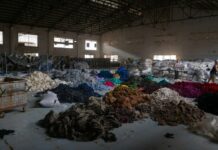The textile printing industry is a vibrant sector that constantly evolves with technological advancements and shifts in global trade policies. In 2025, the landscape is notably shaped by the complexities of supply chains and changing trade dynamics. These elements have profound impacts on how businesses operate within the industry. Companies face numerous challenges, including fluctuating raw material costs and regulatory changes. To navigate these turbulent waters, industry players must adapt and implement innovative strategies for sustainability and efficiency.
Current Supply Chain Challenges in Textile Printing
Raw Material Shortages
In 2025, raw material shortages continue to present significant challenges for the textile printing industry. The disruptions caused by the COVID-19 pandemic have had lasting effects on the availability of critical materials such as cotton, polyester, and specialized inks. With material shortages, textile printers are finding it increasingly difficult to maintain consistency in production quality and volumes. Moreover, the pressure to source sustainable materials has intensified, further complicating supply chain operations. This scarcity not only drives up costs but also prompts industry players to seek alternative sources and innovative materials to remain competitive.
Transportation and Logistics Disruptions
The transportation and logistics sectors are crucial links in the textile printing supply chain. However, these areas have not been immune to disruptions. Rising fuel costs, a global shortage of shipping containers, and port congestions have led to delays and increased transportation costs. Furthermore, labor shortages in key logistical roles exacerbate these challenges, resulting in unpredictable lead times for shipments. Textile printing companies must, therefore, adopt more agile logistics strategies, including diversifying transportation modes and adopting technology solutions to overcome these hurdles.
Global Trade Dynamics and Textile Printing
Fluctuating Trade Policies
Trade policies are ever-evolving, and in 2025, they play a pivotal role in shaping the landscape for textile printing firms. Countries continue to recalibrate their trade priorities, often resulting in the sudden imposition of tariffs or stringent import/export regulations. Such fluctuations create an uncertain environment for textile printers who rely heavily on cross-border supply chains. Businesses are compelled to keep a constant eye on policy changes to anticipate any potential impacts on their operations and adjust their strategies accordingly.
Impact of Tariffs and Trade Agreements
Tariffs and trade agreements significantly influence global trade, and their effects resonate deeply within the textile printing sector. While some agreements foster market access and reduce costs, new tariffs can suddenly inflate prices and limit the availability of foreign materials and products. Textile printing firms need to navigate these complexities by leveraging trade negotiations to their advantage and advocating for favorable terms that support industry growth and sustainability.
Currency Exchange Rate Volatility
Currency exchange rate volatility is another critical factor affecting global trade dynamics for the textile printing industry. Fluctuating exchange rates can lead to unpredictable costs for importing raw materials and exporting finished goods. This volatility can erode profit margins and require businesses to implement robust currency risk management strategies. By employing hedging techniques and diversifying their market presence, textile printers can mitigate the adverse effects of exchange rate swings, ensuring more stable financial performance amidst global trade uncertainties.
Technological Advancements and Innovations
The textile printing industry is undergoing a significant transformation due to technological advancements and innovations. The sector is embracing new technologies to address supply chain challenges and become more adaptive to the global trade dynamics impacting the industry as we move through 2025.
Digital Printing Technologies
One of the most critical changes is the shift towards digital printing technologies. These technologies offer increased efficiency, flexibility, and mass customization. Digital printing allows for shorter lead times and reduced waste, as only the required amount of fabric is printed. This method is particularly advantageous in an era where demand is highly unpredictable due to fluctuating global trade policies. Additionally, digital printing provides an opportunity for textile producers to create diverse, high-quality designs that can satisfy various market segments without the constraints of traditional methods.
Sustainable Practices and Materials
Sustainability has become a cornerstone of technological innovation within the textile printing industry. Companies are now integrating sustainable practices by utilizing eco-friendly dyes and organic materials. The use of waterless dyeing processes and the development of biodegradable materials are gaining traction, addressing environmental concerns and meeting the growing consumer demand for sustainable products. In addition, advancements in recycling technologies are allowing for the repurposing of textile waste, contributing to a more circular economy.
Automation and AI Integration
The integration of automation and artificial intelligence (AI) throughout the textile printing process is revolutionizing the industry. Automation enhances production efficiency by reducing human error and improving quality control. AI-driven data analytics enable companies to forecast demand more accurately and optimize inventory management. These technologies collectively arm businesses with the ability to adapt quickly to market changes, ensuring a competitive edge in a complex global trade environment.
Strategies for Navigating Challenges
Given the current global landscape, textile printing companies are implementing strategic measures to navigate industry challenges effectively.
Diversifying Supply Sources
One key strategy is diversifying supply sources. By engaging multiple suppliers, companies can mitigate risks associated with supply chain disruptions. This approach increases resilience against geopolitical tensions, natural disasters, and other uncertainties that can impact resource availability.
Strengthening Local Partnerships
Building and strengthening local partnerships is another crucial strategy. Collaborating with local suppliers and manufacturers not only reduces dependency on foreign resources but also supports regional economies. Local partnerships facilitate quicker response times to market demands and ensure a more agile supply chain.
Investing in Technology and R&D
To stay competitive, investing in technology and research and development (R&D) is imperative. Companies focusing on innovation are better equipped to anticipate market trends and respond to shifts in consumer preferences. This investment not only enhances production capabilities but also fosters the creation of cutting-edge textile products that meet the evolving needs of a global audience.
By leveraging these strategies and embracing technological innovations, the textile printing industry is positioned to overcome the challenges of 2025, ensuring sustainable growth and success in a dynamically shifting market landscape.
Conclusion
The textile printing industry in 2025 finds itself at the intersection of evolving supply chain complexities and shifting global trade dynamics. To navigate these challenges effectively, businesses must remain agile and forward-thinking. Proactive strategy implementation is essential, with a focus on enhancing supply chain resilience and leveraging technological advancements. Additionally, maintaining a keen awareness of global trade policies will equip industry players to adapt swiftly to changes. By embracing these strategies, the textile printing industry can thrive despite prevailing challenges.



































